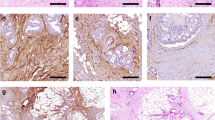Abstract
Aim
The aim of this study was to investigate the role of ADAMTS12 in colorectal cancer progression and to examine whether ADAMTS-12 can be considered as a prognostic indicator for colorectal cancer.
Methods
This study was performed on formalin-fixed paraffin-embedded resected specimens obtained from 112 patients with colorectal cancer. The expression level of ADAMTS12 was investigated by immunohistochemical staining to assess the relationship between ADAMTS12 expression and the clinicopathologic factors and to study the prognostic significance of ADAMTS12 in colorectal cancer patients.
Results
ADAMTS12 expression was mainly localized in the fibroblasts adjacent to the tumor cells or in macrophages in front of the invasive cancer margins. The ADAMTS12 expression was significantly correlated with the tumor histological grade, depth of tumor invasion, lymph node metastasis, and Dukes’ stage. Patients with low or no ADAMTS12 expression in the tumor stroma had a significantly poor overall survival or disease-free survival.
Conclusion
The expression of ADAMTS12 in colorectal cancer stroma plays an important role in inhibiting tumor development. Patients with ADAMTS12 expression showed better prognosis than those without ADAMTS12 expression. Thus, ADAMTS12 expression may be a good prognostic marker for colorectal cancer.


Similar content being viewed by others
References
Hanahan D, Weinberg RA. The hallmarks of cancer. Cell. 2000;100:57–70.
Freije JM, Balbin M, Pendas AM, Sanchez LM, Puente XS, Lopez-Otin C. Matrix metalloproteinases and tumor progression. Adv Exp Med Biol. 2003;532:91–107.
Illemann M, Bird N, Majeed A, et al. MMP-9 is differentially expressed in primary human colorectal adenocarcinomas and their metastases. Mol Cancer Res. 2006;4:293–302.
Apte SS. A disintegrin-like and metalloproteases (reprolysin type) with thrombospondin type 1 motifs: the ADAMTS family. Int J Biochem Cell Biol. 2004;36:981–985.
Cal S, Obaya AJ, Llamazares M, Garabaya C, Quesada V, Lopez-Otin C. Cloning, expression analysis, and tructural characterization of seven novel human DAMTSs, a family of metalloproteinases with disintegrin and thrombospondin-1 domains. Gene. 2002;283:49–62.
Porter S, Clark IM, Kevorkian L, Edwards DR. The ADAMTS etalloproteinases. Biochem J. 2005;386:15–27.
Balbin M, Fueyo A, Tester AM, et al. Loss of collagenase-2 confers increased skin tumor susceptibility to male mice. Nat Genet. 2003;35:252–257.
Lopez-Otin C, Matrisian LM. Emerging roles of proteases in tumour suppression. Nat Rev Cancer. 2007;7:800–808.
Lind GE, Kleivi K, Meling GI, et al. ADAMTS1, CRABP1, and NR3C1 identified as epigenetically deregulated genes in colorectal tumorigenesis. Cell Oncol. 2006;28:259–272.
Dunn JR, Panutsopulos D, Shaw MW. METH-2 silencing and promoter hypermethylation in NSCLC. Br. J Cancer. 2004;91:1149–1154.
Lo PH, Leung AC, Kwok CY, et al. Identification of a tumor suppressive critical region mapping to 3p14.2 in esophageal squamous cell carcinoma and studies of a candidate tumor suppressor gene, ADAMTS9. Oncogene. 2007;26:148–157.
Jin H, Wang X, Ying J, et al. Epigenetic identification of ADAMTS18 as a novel 16q23.1 tumor suppressor frequently silenced in esophageal, nasopharyngeal and multiple other carcinomas. Oncogene. 2007;26:7490–7498.
Cal S, Arguelles JM, Fernandez PL. and Lopez-Otin, C: Identification, characterization, and intracellular processing of ADAM-TS12, a novel human disintegrin with a complex structural organization involving multiple thrombospondin-1 repeats. J Biol Chem. 2001;276:17932–17940.
Liu CJ, Kong W, Xu K, et al. ADAMTS-12 associates with and degrades cartilage oligomeric matrix protein. J Biol Chem. 2006;281:15800–15808.
Llamazares M, Obaya AJ, Moncada-Pazos A, et al. The ADAMTS12 metalloproteinase exhibits anti-tumorigenic properties through modulation of the Ras-dependent ERK signaling pathway. J. Cell ScI. 2007;120:3544–3552.
Moncada-Pazos A, Obaya AJ, Fraga MF, et al. The ADAMTS12 metalloprotease gene is epigenetically silenced in tumor cells and transcriptionally activated in the stroma during progression of colon cancer. J Cell Sci. 2009;15:2906–2913.
Zhou D, Pan G, Zheng C, Zheng J, Yian L, Teng X. Expression of the RON receptor tyrosine kinase and its association with gastric carcinoma versus normal gastric tissues. BMC Cancer. 2008;8:353.
Gordon S. Alternative activation of macrophages. Nat Rev Immunol. 2003;3:23–35.
Author information
Authors and Affiliations
Corresponding author
Rights and permissions
About this article
Cite this article
Wang, D., Zhu, T., Zhang, FB. et al. Expression of ADAMTS12 in Colorectal Cancer-Associated Stroma Prevents Cancer Development and Is a Good Prognostic Indicator of Colorectal Cancer. Dig Dis Sci 56, 3281–3287 (2011). https://doi.org/10.1007/s10620-011-1723-x
Received:
Accepted:
Published:
Issue Date:
DOI: https://doi.org/10.1007/s10620-011-1723-x




